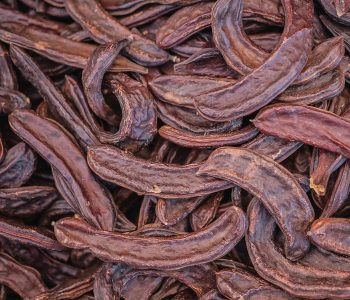Carob, scientifically known as Ceratonia siliqua L., is a common Mediterranean tree known for providing its fruit pulp for animal nutrition. Recently, researchers from the University of Lleida uncovered a range of advantageous nutritional elements associated with its utilization.
In particular, the research focused on examining how carob pulp impacts “gastrointestinal morphological aspects, immune-redox defenses, and coccidiosis in light lambs fed with concentrates during both their diet and the warm season.”
This research, conducted by Jonathan Pelegrin-Valls et al., arose as a potential response to the havoc that the climate emergency will soon wreak on animal nutrition. As the team explains:
“Animal production will face significant challenges in terms of feeding systems due to global warming (Godde et al., 2021). Therefore, feeding strategies used in the Spanish meat sheep sector will be crucial to mitigate these effects. Although high concentrate diets can improve the productive efficiency of ruminants, they can also promote metabolic disorders and altered ruminal environments (Metzler-Zebeli et al., 2013). The use of polyphenols, specifically condensed tannins (CT), in ruminant production has been studied for their influence on nutrition, productivity, and health, with both beneficial and harmful effects (Mueller-Harvey, 2006; Pelegrin-Valls et al., 2022)”.
In the study, three diets based on concentrates were introduced to lambs after weaning. The initial diet (C0) lacked carob pulp, the second diet (C15) included 150 g/kg of carob pulp, and the third diet (C30) incorporated 300 g/kg of carob pulp. The implementation occurred over “two successive batches under both cold and hot conditions.”
On days 50, 65, and 80, rectal feces were evaluated “to determine consistency and oocyst count per gram.” Also, on day 80, blood samples were collected from each group to assess metabolic states.
Consequently, it was observed that incorporating carob pulp led to a “decrease in the excretion of coccidia oocysts, enhanced fecal consistency, and improvements in gastrointestinal morphological aspects.” This included an increase in the ruminal thickness of the vital layers of the papilla and a reduction in the darkness of the epithelial color. Additionally, it was highlighted that:
“… immune and antioxidant regulatory mechanisms were apparent in mitigating the production of reactive oxygen species in gastrointestinal tissues. The incorporation of carob pulp (at 150 and 300 g/kg) into the lamb diet enhanced gastrointestinal health and maintained homeostasis, yet it did not alleviate the adverse effects of the warm season.”
Nevertheless, lambs subjected to thermal stress exhibited a decelerated growth rate. Despite the previously mentioned positive impacts of carob pulp on animal health, it does not seem to represent an effective measure for mitigating the damage induced by heat in this species.
The full research can be accessed here.
You may also like to read: “Palm kernel cake and meal (Raw materials sheet).”
Source: Jonathan Pelegrin-Valls, Javier Álvarez-Rodríguez, María José Martín-Alonso, Beatriz Aquilué, Beatriz Serrano-Pérez. (2023). Impact of carob (Ceratonia siliqua L.) pulp inclusion and warm season on gastrointestinal morphological parameters, immune-redox defences and coccidiosis in concentrate-fed light lambs, Research in Veterinary Science, Volume 163, 2023, 104969, ISSN 0034-5288, https://doi.org/10.1016/j.rvsc.2023.104969.
